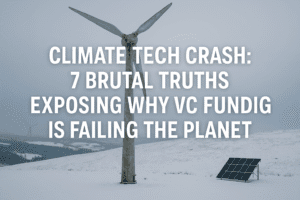Climate Tech Crash: 7 Brutal Truths Exposing Why VC Funding Is Failing the Planet
Climate tech investment faces a severe downturn, dropping nearly 15% globally in 2024 and plummeting over 80% in India by mid-2025, as traditional venture capital’s demand for quick returns clashes with the sector’s long development timelines and massive infrastructure needs. This structural mismatch leaves promising hardware-heavy solutions—like green steel or battery plants—starved of patient capital, widening the “valley of death” between innovation and scale. While AI-driven climate solutions and adaptation tech show resilience, the broader retreat exposes a failed financing model.
New approaches are emerging, notably in Europe, where creative debt structures and blended finance de-risk large projects. A lasting recovery requires systemic change: investors accepting longer horizons, policymakers enabling projects through guarantees and carbon pricing, and startups proving viable economics beyond green branding. The crisis underscores that solving a planetary emergency demands financial innovation as urgently as technological breakthroughs. Success hinges on building a capital ecosystem aligned with climate tech’s physical reality and decade-long horizons

.
Climate Tech Crash: 7 Brutal Truths Exposing Why VC Funding Is Failing the Planet
The climate crisis demands urgent solutions, yet the financial engine supposed to drive innovation is sputtering. The stark reality revealed in recent data is a wake-up call: traditional venture capital is fundamentally misaligned with the needs of the technologies that could save our planet. This isn’t just a downturn; it’s a structural crisis demanding a radical reinvention of climate finance.
The Funding Freeze in Stark Relief
The numbers paint a chilling picture of retreat:
- Global Chill: Climate tech investment plummeted from $51 billion in 2023 to $41.1 billion in 2024 – a nearly 15% contraction.
- India’s Deep Freeze: The drop is even more severe domestically. Funding collapsed from $1.66 billion (157 deals) in 2023 to a mere $270 million (37 deals) in the first half of 2025. Average deal sizes halved.
- Concentration Risk: Resilience exists only in narrow lanes – clean energy, electric mobility (like Euler Motors’ $75M raise), and AI-driven solutions. Tellingly, the top 5 deals in India swallowed 68% of total funding, revealing a flight to perceived “safer,” scalable bets.
Why VC is the Wrong Tool for the Job
The core problem isn’t just market jitters; it’s a fundamental mismatch:
- The Long Game vs. The Quick Flip: Building a battery gigafactory, decarbonizing steel production, or revolutionizing sustainable agriculture takes years, massive upfront capital, and involves complex hardware and infrastructure. This clashes violently with the VC model’s typical 3-7 year exit horizon craving rapid, software-like scalability.
- The Valley of Death Widens: Early-stage climate tech faces a perilous gap. VCs shy away from long gestation. Private Equity wants cash flow now. Banks fear early-stage risk. Promising ideas die on the vine, lacking the patient capital needed to bridge development to commercial scale.
- Macro Headwinds Bite: High interest rates amplify the problem, making capital more expensive and eroding investor confidence. Sectors like industrial decarbonization and climate-smart agriculture remain chronically underfunded. Plummeting IPO exits (down 65% in 2023) further strangle the VC model.
Seeds of a New Model: Finance Adapts (Slowly)
Despite the gloom, necessity is sparking innovation in financing:
- Beyond Equity: Europe leads with creative debt solutions. Witness the €3.3 billion in conditional commitments for H2 Green Steel – a model involving banks willing to shoulder risk for proven technology and offtake agreements.
- The Rise of Specialists: Alternative lenders and growth-stage financiers focused specifically on climate infrastructure are stepping into the void left by generalist VCs.
- Blending is Key: The future lies in blended finance – strategically layering public capital, concessional finance, philanthropic grants, and commercial debt/equity to de-risk projects and attract private investment. Project-specific instruments and layered risk-sharing models are becoming essential tools.
- Bright Spots Signal Demand: AI-powered climate solutions ($6B raised in 9 months of 2024, +20% YoY) and Adaptation & Resilience tech (now 28% of deals) prove investors will back solutions with clear, near-term market demand and risk mitigation value as climate impacts become undeniable.
The Path Forward: Building for the Long Haul
A fragile rebound may be starting, driven by corporate investors (like Aramco Ventures) and landmark deals (H2 Green Steel’s $4.5B debt + equity, Natron’s $189M). The shakeout, as Extantia Capital’s Yair Reem notes, is cleansing the field of hype, leaving stronger contenders.
But true success demands systemic change:
- Patient Capital Imperative: Climate tech needs investors comfortable with 10-15 year horizons, accepting lower-but-steady returns aligned with infrastructure, not apps. Pension funds, sovereign wealth funds, and specialized climate asset managers must step up.
- Policy as a Catalyst: Governments must de-risk investment through stronger carbon pricing, guaranteed offtake agreements (like the US Inflation Reduction Act model), streamlined permitting, and direct support for R&D and first-of-a-kind deployments.
- Realistic Expectations: Startups need to demonstrate credible paths to profitability beyond just being “green.” Revenue traction and unit economics matter more than ever.
- Financial Innovation Acceleration: The development and scaling of new instruments – sustainability-linked bonds, green securitization, adaptation insurance pools – must be prioritized.
The Bottom Line: The climate tech funding winter exposes a brutal truth: we can’t solve a physical world crisis with digital-world financing. The sector’s survival and growth hinge on moving beyond the failed VC orthodoxy. It demands a collaborative effort to build a new financial architecture – one characterized by patience, ingenuity, policy courage, and a deep understanding that saving the planet is the ultimate long-term investment. The innovation needed isn’t just technological; it’s profoundly financial. The clock is ticking.
You must be logged in to post a comment.